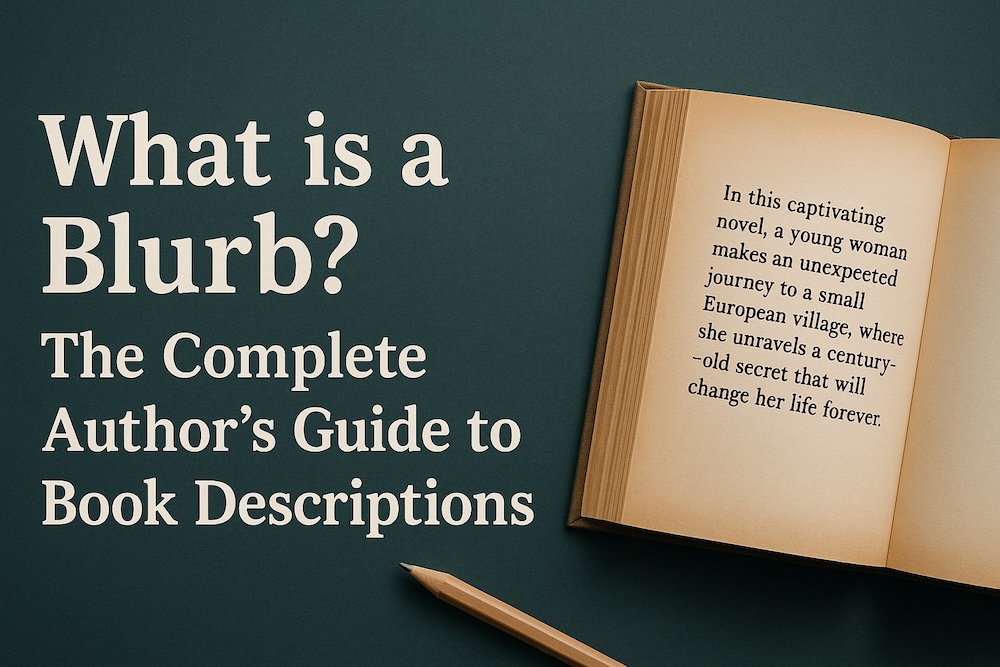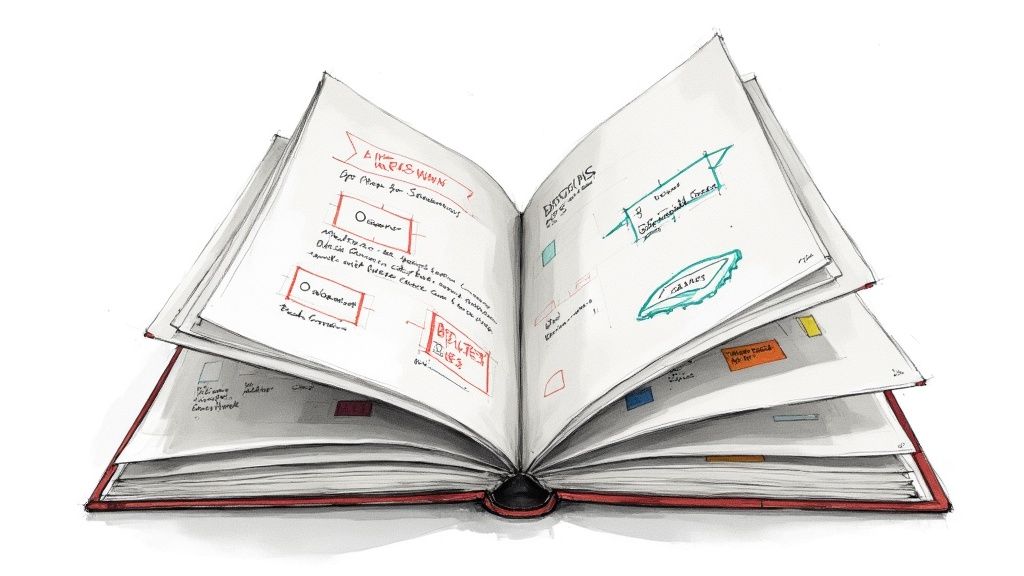What Is a Book Blurb? Definition + 10 Real Examples (2025)

Quick Definition
A book blurb is a short, persuasive sales description (150-250 words) that appears on a book's back cover or online product page. Its purpose is to hook potential readers and convince them to buy the book—not to summarize the entire story.
Key characteristics:
- Length: 150-250 words
- Purpose: To sell, not inform
- Content: Hook, conflict, stakes—never the ending
- Location: Back covers, Amazon listings, promotional materials
The term "blurb" was coined by humorist Gelett Burgess in 1907 to describe promotional text on book jackets. Today, it's the industry standard for any short promotional book description.
Jump to: Real Examples | Blurb vs Synopsis | How to Write
10 Real Book Blurb Examples
Learning from successful blurbs is the fastest way to understand what works. Here are 10 examples from bestsellers:
1. Thriller: Gone Girl by Gillian Flynn
"On the morning of his fifth wedding anniversary, Nick Dunne's wife Amy suddenly disappears. The police immediately suspect Nick. Amy's friends reveal that she was afraid of him, that she kept secrets from him. He swears it isn't true..."
Why it works: Opens with immediate mystery, raises suspicion, builds tension without revealing the twist.
2. Romance: The Hating Game by Sally Thorne
"Lucy Hutton has always been certain that the nice girl can get the corner office. She's charming and accommodates, and she's worked hard to get her job... But there's one problem: Joshua Templeman. Her nemesis, her opposite, her office enemy."
Why it works: Establishes enemies-to-lovers dynamic, introduces both leads, creates romantic tension.
3. Fantasy: The Name of the Wind by Patrick Rothfuss
"My name is Kvothe, pronounced nearly the same as 'quothe.' Names are important as they tell you a great deal about a person. I've had more names than anyone has a right to. I have been called Kvothe the Bloodless, Kvothe the Arcane, and Kvothe Kingkiller..."
Why it works: Character-driven hook, hints at mysterious past, promises epic journey.
4. Literary Fiction: The Kite Runner by Khaled Hosseini
"Afghanistan, 1975: Twelve-year-old Amir is desperate to win the local kite-fighting tournament and his loyal friend Hassan promises to help him. But neither of the boys can foresee what will happen to Hassan that afternoon..."
Why it works: Sets up emotional stakes, historical context, foreshadows tragedy without spoiling.
5. Mystery: The Girl with the Dragon Tattoo by Stieg Larsson
"Forty years ago, Harriet Vanger disappeared from a family gathering on the island owned by the powerful Vanger clan. Her body was never found, yet her uncle is convinced it was murder—and that the killer is a member of his own tightly knit but dysfunctional family."
Why it works: Long-standing mystery, family secrets, clear stakes and protagonist goal.
6. Non-Fiction: Atomic Habits by James Clear
"No matter your goals, Atomic Habits offers a proven framework for improving—every day. James Clear, one of the world's leading experts on habit formation, reveals practical strategies that will teach you exactly how to form good habits, break bad ones, and master the tiny behaviors that lead to remarkable results."
Why it works: States the problem, promises solution, establishes author authority.
7. YA: The Hunger Games by Suzanne Collins
"In the ruins of a place once known as North America lies the nation of Panem, a shining Capitol surrounded by twelve outlying districts. The Capitol is harsh and cruel and keeps the districts in line by forcing them all to send one boy and one girl between the ages of twelve and eighteen to participate in the annual Hunger Games, a fight to the death on live TV..."
Why it works: World-building, high stakes, shocking premise that hooks readers.
8. Memoir: Educated by Tara Westover
"Tara Westover was seventeen the first time she set foot in a classroom. Born to survivalists in the mountains of Idaho, she prepared for the end of the world by stockpiling home-canned peaches and sleeping with her 'head-for-the-hills bag.' Her family was so isolated from mainstream society that there was no one to ensure the children received an education..."
Why it works: Shocking opening fact, builds curiosity about transformation.
9. Historical Fiction: All the Light We Cannot See by Anthony Doerr
"Marie-Laure lives in Paris near the Museum of Natural History, where her father works. When she is twelve, the Nazis occupy Paris and father and daughter flee to the walled citadel of Saint-Malo, where Marie-Laure's reclusive great uncle lives in a tall house by the sea. With them they carry what might be the museum's most valuable and dangerous jewel."
Why it works: Historical setting, multiple storylines, hints at danger.
10. Self-Help: The 4-Hour Work Week by Tim Ferriss
"Forget the old concept of retirement and the rest of the deferred-life plan—there is no need to wait and every reason not to, especially in unpredictable economic times. Whether your dream is escaping the rat race, experiencing high-end world travel, or earning a monthly five-figure income with zero management, The 4-Hour Work Week is the blueprint."
Why it works: Challenges conventional wisdom, promises specific results, speaks to reader desires.
These examples show different content approaches (thriller, romance, literary, etc.). To learn different writing styles (Hook Opening, Character-Driven, Stakes-Driven), see our 6 blurb style examples guide.
Blurb vs Synopsis vs Summary
Understanding the difference between these three is crucial for authors:
| Element | Blurb | Synopsis | Summary |
|---|---|---|---|
| Purpose | Sell the book | Evaluate the story | Inform about content |
| Audience | Potential readers | Agents/editors | General information |
| Length | 150-250 words | 1-2 pages | Varies |
| Ending | Never revealed | Always revealed | May or may not include |
| Tone | Exciting, mysterious | Professional, clear | Neutral, factual |
The Blurb: Your Sales Tool
A blurb is pure marketing designed for readers deciding whether to buy. It creates intrigue without revealing plot points and ends with compelling questions.
Example: "When Sarah discovers her husband's secret journal, she uncovers a web of lies that threatens everything she thought she knew about their marriage..."
The Synopsis: Your Professional Document
A synopsis reveals your entire plot, including the ending. It's for agents and publishers who need to evaluate your story's structure. Learn more in our synopsis writing guide.
Example: "Sarah Mitchell, a 34-year-old executive, discovers her husband's affair with her sister, leading to divorce and a fresh start in Portland..."
The Summary: Informational Overview
A summary provides neutral, factual description for academic contexts or library catalogs—informational rather than promotional.
The Anatomy of an Effective Blurb
Every successful blurb follows a three-part structure:
1. The Hook
Your opening sentence must stop readers mid-scroll. Use one of these proven techniques:
- Intriguing Question: "What would you do if your entire life was a lie?"
- Shocking Statement: "The first victim had one black rose. The second had two."
- Impossible Situation: "Time travel was supposed to save her daughter—not erase her."
- Character in Crisis: "Detective Chen had solved every case—until the body with no fingerprints."
2. The Conflict & Stakes
Introduce your protagonist and central problem in 2-3 sentences. Answer:
- Who is this happening to?
- What's the problem?
- What's at risk? (personal, professional, physical, or existential)
Keep it compelling: not "John Smith is a detective" but "Detective Smith has solved every case in 20 years—until now."
3. The Tease
End with a compelling question or impossible choice that creates urgency.
Weak: "Will Sarah find the truth?"
Strong: "When Sarah discovers the journal's final entry—dated three days in the future—she realizes the lies were just the beginning."
Genre-Specific Blurb Tips
Match your blurb to genre expectations:
Romance: Introduce both leads, establish why they can't be together, hint at chemistry. End with the central romantic question. See our romance marketing guide for more.
Mystery/Thriller: Open with the crime or threat, show protagonist's connection, escalate stakes. Use short, punchy sentences. Never reveal whodunit.
Fantasy/Sci-Fi: Lead with character conflict, not world-building. Ground fantastical elements in relatable emotions. Instead of "In Xylothia, the Crystals of Maethon..." try "Mira's fire powers made her strong—until she became the key to preventing war."
Literary Fiction: Focus on internal conflict and themes. Use sophisticated language. Emphasize character growth over plot.
5 Common Blurb Mistakes to Avoid
1. Revealing Too Much Plot
Wrong: Listing every plot point like a synopsis.
Right: Create intrigue. "Sarah's fresh start in Portland isn't what it seems. The stranger watching her is just the beginning."
2. Generic Clichés
Avoid: "A gripping tale of..." "An unforgettable journey..." "In a world where..."
Use: Specific, active language. "One wrong move could cost her everything."
3. Too Many Characters/Subplots
Focus on your protagonist's main conflict. Don't confuse readers with minor characters or subplot details.
4. Wrong Genre Tone
Match your tone to reader expectations. A comedic horror blurb or serious rom-com confuses buyers. Study successful books in your genre.
5. Burying Your Hook
Weak: "Sarah had a good job, nice house, and loving husband. But when she found David's journal..."
Strong: "The journal revealed a man Sarah had never met—and a conspiracy that shattered her marriage."
Get Professional Blurb Help
Writing an effective blurb requires objectivity many authors lack after spending months with their story. ManuscriptReport.com uses AI trained on thousands of successful campaigns to identify your story's strongest hooks, conflicts, and target audience.
What you get:
- Multiple blurb variations optimized for your genre
- Character arc and conflict analysis
- Target audience profiling
- Amazon keyword optimization
- Comparable titles and KDP categories
- Complete marketing assets (social media content, ad copy, blog posts)
A blurb that converts just 1-2% better can mean hundreds of additional sales over your book's lifetime. Learn more about our affordable book marketing services.
Frequently Asked Questions
What is the difference between a blurb and a synopsis?
A blurb is a short marketing description (150-250 words) designed to entice readers to buy your book. It creates mystery and never reveals the ending. A synopsis is a comprehensive plot summary (1-2 pages) for industry professionals that reveals the entire story, including the ending.
How long should a book blurb be?
Most effective blurbs are 150-250 words. Amazon displays only the first 20-30 words before requiring readers to click "read more," so your opening hook must be particularly strong.
Should I reveal the ending in my blurb?
Never reveal the ending in a blurb. Unlike a synopsis, a blurb's job is to create intrigue and compel readers to buy. Revealing major plot points eliminates the reader's motivation to purchase.
Do blurbs differ by genre?
Yes, blurbs should match genre expectations. Romance blurbs focus on relationship conflict, mystery/thriller blurbs build suspense, fantasy/sci-fi blurbs balance world-building with character conflict, and literary fiction emphasizes themes and character growth.
Master Your Book's Most Important Sales Tool
A compelling blurb is often your only chance to convince potential readers your book is worth buying. Remember the key principles:
- Hook immediately with shocking statements or intriguing questions
- Establish conflict and stakes in 2-3 sentences
- End with a tease that creates urgency
- Match your genre's tone and reader expectations
- Never reveal major plot points or the ending
For more help with book marketing, explore our guides on how to write a book blurb and see real blurb examples.
Ready to create blurbs that convert? ManuscriptReport.com analyzes your manuscript and generates compelling blurbs that capture your story's most marketable elements.
